Robert was intrigued by the art he saw during his Grand Tour abroad and was one of the main contributors to the art collection at Althorp. He designed the dominant style of frame that is seen at Althorp, called "the Sunderland frame", but unfortunatley he found that his expensive tastes could not be funded by his Spencer inheritance, and so he became susceptible to bribery and corruption, even resorting to treason and disloyalty to three Kings.
Robert inherited his father's peerage dignities at the age of three, becoming Baron Spencer of Wormleighton and Earl of Sunderland. He joined the British Army, eventually becoming a captain in the Prince Rupert Regiment of Horse.
Robert became an English statesman who was one of the most influential advisers during the reigns of Charles II, James II, and William III. His ability to shift allegiances was both the secret of his success and the cause of his unpopularity. Driven by his lust for power and money, Robert always allowed his conscience to take a back-seat to his ambition, making him one of the most influential, but unpopular politicians of the seventeenth century.
Robert married Lady Anne Digby, the daughter of George Digby, 2nd Earl of Bristol on June 10, 1665. Seven children were born to this union, with three dying young.
Robert served as ambassador to Madrid from 1671-1672, ambassador to Paris from 1672-1673, and the United Provinces in 1673. He was a Gentleman of the Bedchamber under the reign of Charles II from 1673 to 1679. He was invested a Privy Councilor and appointed Secretary of State for the Northern Dept. in 1679, also serving as Ambassador Extraordinary to Paris. He served as Lord Lieutenant of Staffordshire during the minority of Lord Shrewbury until 1681. Between 1682 and 1688, he intermittently served as Secretary of State for the Southern Dept., Lord Lieutenant of Warwickshire, and Lord President of the Council.
The year of 1687 was a busy year for Robert. He signed the King's grant of religious freedom for the Brenttown tract in Old Prince William County, Va. to help encourage settlement of French Protestants and he openly accepted and embraced the Roman Catholic faith in order to please King James II and was awarded the Knight of the Garter.
Robert fled to Utrecht, the Netherlands. He sought the help of a prominent English Statesman, Sir John Churchill. By 1691 he was allowed to return to his country and began sitting in the House of Lords. Robert, a staunch Whig supporter, became an influential advisor to William III, which caused the King to only accept Whigs in his government.
In 1697 he became Lord Chamberlain of the Household, also serving as Lord Justice for a brief period of time, but was forced out of office by a distrustful Parliament by the end of the year and condemned as "the subtilest workinest villain that is on the face of the earth".
Robert retired and led a secluded life unit he passed away at Althorp.
Robert was intrigued by the art he saw during his Grand Tour abroad and was one of the main contributors to the art collection at Althorp. He designed the dominant style of frame that is seen at Althorp, called "the Sunderland frame", but unfortunatley he found that his expensive tastes could not be funded by his Spencer inheritance, and so he became susceptible to bribery and corruption, even resorting to treason and disloyalty to three Kings.
Robert inherited his father's peerage dignities at the age of three, becoming Baron Spencer of Wormleighton and Earl of Sunderland. He joined the British Army, eventually becoming a captain in the Prince Rupert Regiment of Horse.
Robert became an English statesman who was one of the most influential advisers during the reigns of Charles II, James II, and William III. His ability to shift allegiances was both the secret of his success and the cause of his unpopularity. Driven by his lust for power and money, Robert always allowed his conscience to take a back-seat to his ambition, making him one of the most influential, but unpopular politicians of the seventeenth century.
Robert married Lady Anne Digby, the daughter of George Digby, 2nd Earl of Bristol on June 10, 1665. Seven children were born to this union, with three dying young.
Robert served as ambassador to Madrid from 1671-1672, ambassador to Paris from 1672-1673, and the United Provinces in 1673. He was a Gentleman of the Bedchamber under the reign of Charles II from 1673 to 1679. He was invested a Privy Councilor and appointed Secretary of State for the Northern Dept. in 1679, also serving as Ambassador Extraordinary to Paris. He served as Lord Lieutenant of Staffordshire during the minority of Lord Shrewbury until 1681. Between 1682 and 1688, he intermittently served as Secretary of State for the Southern Dept., Lord Lieutenant of Warwickshire, and Lord President of the Council.
The year of 1687 was a busy year for Robert. He signed the King's grant of religious freedom for the Brenttown tract in Old Prince William County, Va. to help encourage settlement of French Protestants and he openly accepted and embraced the Roman Catholic faith in order to please King James II and was awarded the Knight of the Garter.
Robert fled to Utrecht, the Netherlands. He sought the help of a prominent English Statesman, Sir John Churchill. By 1691 he was allowed to return to his country and began sitting in the House of Lords. Robert, a staunch Whig supporter, became an influential advisor to William III, which caused the King to only accept Whigs in his government.
In 1697 he became Lord Chamberlain of the Household, also serving as Lord Justice for a brief period of time, but was forced out of office by a distrustful Parliament by the end of the year and condemned as "the subtilest workinest villain that is on the face of the earth".
Robert retired and led a secluded life unit he passed away at Althorp.
Family Members
Advertisement
Advertisement








